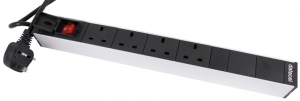
PDU (Power Distribution Unit): Explained in Simple Terms
Ever wondered how all those servers and network devices stay powered in a data center? The answer: Power Distribution Units (PDU).
Think of a PDU as a glorified power strip, but much more robust and designed specifically for data center environments. It takes a single power source and distributes it to multiple devices through its outlets.
Here’s why PDUs are essential:
- Organized power delivery: Keeps your data center cabling neat and manageable.
- Monitoring capabilities (on some models): Tracks power usage for better energy efficiency.
- Reliable power supply: Ensures consistent performance for your critical IT equipment.
A PDU is used to distribute power, typically to networking and computer hardware housed in a rack in a data centre. A basic PDU has one input and multiple outputs, each designed to supply power to one piece of equipment.
A stable power supply is critical in data centres. Higher-spec PDUs can be monitored to check their efficiency. Here we break down the types of PDU typically used, together with their key features.
The key features of a PDU include:
- Power Input: A PDU typically connects to a power source and can receive power from a single-phase or three-phase power source.
- Power Output: A PDU provides power to multiple devices through its outlets, which can be configured as C13, C19, or other types depending on the equipment being powered.
- Load Monitoring: PDUs are equipped with sensors that measure the power consumption of each outlet, enabling users to monitor power usage and identify potential issues.
- Remote Access: Many PDUs can be accessed remotely via a network connection, allowing administrators to monitor and control power usage from a central location.
- Redundancy: PDUs can be configured with redundant power inputs and outlets, ensuring that power is always available even in the event of a power outage or equipment failure.
- Surge Protection: PDUs can be equipped with surge protection to prevent damage to connected equipment from power surges.
- Mounting Options: PDUs are available in a variety of form factors, including rack-mount, wall-mount, and vertical-mount, to fit different installation scenarios.
- User Authentication: Many PDUs feature user authentication and access control, enabling administrators to restrict access to the device and prevent unauthorized changes.
- Environmental Monitoring: Some PDUs can monitor environmental factors such as temperature and humidity, providing administrators with valuable information to maintain optimal conditions in the data center or server room.

Standard Cabinet PDUs
Comms Express stocks a wide range of standard cabinet PDUs. We have various configurations of input supply, output sockets and additional features. All PDUs are compatible with Comms Express cabinets and have a robust aluminium housing, a 3-metre input lead and an external earth facility.
The input power supply is one of the following four types:
- 13Amp UK plug
- IEC C14 plug (commonly used for desktop computers and monitors)
- 16Amp commando plug (a robust industrial connector with a locking cover)
- 32Amp commando plug
Standard cabinet PDUs have from 4 to 16 output sockets. These sockets are either UK 13Amp or IEC C13 (to fit C14 plugs). Mixed socket PDUs are also available with a combination of C13 and C19 sockets for different equipment.
Optional features are:
- Surge protection against power spikes
- IE C13 integrated locking mechanism on the sockets, as protection against vibration. This holds the earth pin to protect it from being accidentally disconnected. The socket will work with equipment using any C14 or C20 plug.
- A unit switch
- Neon indicator
- Branch circuits (2 x 16Amp circuits)
- Digital ammeter to allow monitoring of the load
Intelligent PDUs
Intelligent PDUs allow for more sophisticated power management such as remote load monitoring. Data centre administrators can then take action to prevent power overload. In some units, individual outputs can be managed remotely, enabling sequencing during power up and power down. Comms Express stocks advanced PDUs from brands like APC, Eaton and Tripp Lite.
APC PDUs
APC Easy PDUs
The APC Easy Rack PDUs are designed for simplicity and reliability. They are easy to install and use, providing dependable power distribution to your rack equipment. These PDUs are ideal for environments where basic power distribution is needed without advanced features.
APC Basic Rack PDUs
APC Basic Rack PDUs offer reliable power distribution through a single input with multiple output receptacles. They are suitable for distributing power from low amperage single-phase circuits to higher-power three-phase solutions. This category includes models like the AP7500 and AP9500. APC basic rack PDUs are rack-mountable and supply power to multiple devices from a single branch whip. Entry-level PDUs distribute a range of voltages at 15 Amps maximum. These PDUs have an IEC-320 C14 or C20 inlet and various outlet combinations of C13 and C19.
APC Switched Rack PDUs
APC Switched Rack PDUs provide advanced, user-customizable power control and active monitoring. They allow remote on/off functionality for power cycling, which is useful for rebooting equipment or restricting unauthorized use. These PDUs also support power sequencing to avoid circuit overloads and offer real-time remote load monitoring.
APC Metered Rack PDUs
APC Metered Rack PDUs focus on energy optimization and circuit protection by providing active metering. They feature user-defined alarm thresholds to warn of potential circuit overloads, helping to mitigate risks. These PDUs provide power utilization data, enabling data center managers to make informed decisions on load balancing and optimizing IT environments.
Each of these categories caters to different needs, from basic power distribution to advanced monitoring and control, ensuring that there is a suitable solution for various IT environments.
Eaton PDUs
Eaton provides a range of PDUs to enable accurate power distribution, monitoring and control.
At the lower end of the range, basic units can distribute power to up to 45 pieces of equipment in a high-density rack environment.
In-line metering can be added to extend the functionality of these basic units. At the high end of the range, both metered and switched outlets are available.
Eaton advanced monitored PDUs allow monitoring of individual outlets, a group of outlets or the full PDU. Power, voltage and amperage are monitored, together with temperature and humidity.
Eaton switched PDUs enable remote control of the unit, including rebooting. Daisy chaining up to 8 PDUs using one IP address reduces the networking cost, this approach is required when using primary and secondary power feeds.
Eaton G3 metered input PDUs introduce phase branch level metering, which enables load balancing.
Metered output PDUs allow administrators to understand power consumption at the individual equipment level, including when supplied by primary and secondary feeds.
Finally, Eaton G3 managed PDUs combine the features of metering and switching, allowing remote management and reboot.
Tripp Lite PDUs
Tripp Lite manufactures a range of PDUs – of similar functionality to APC. Models include basic, switched, metered, auto-transfer and monitored.
The Tripp Lite HotSwap PDU allows for the maintenance of a UPS without affecting connected equipment.
What Is PDU? – Conclusion
As we can see, PDUs come in many forms, from basic functions to advanced monitoring. Whether you need basic or advanced setups, Comms Express is your one-stop shop for all your PDU needs. If you’re struggling to work out which PDU is for you, then have a look at our review of the Top 10 PDUs.
